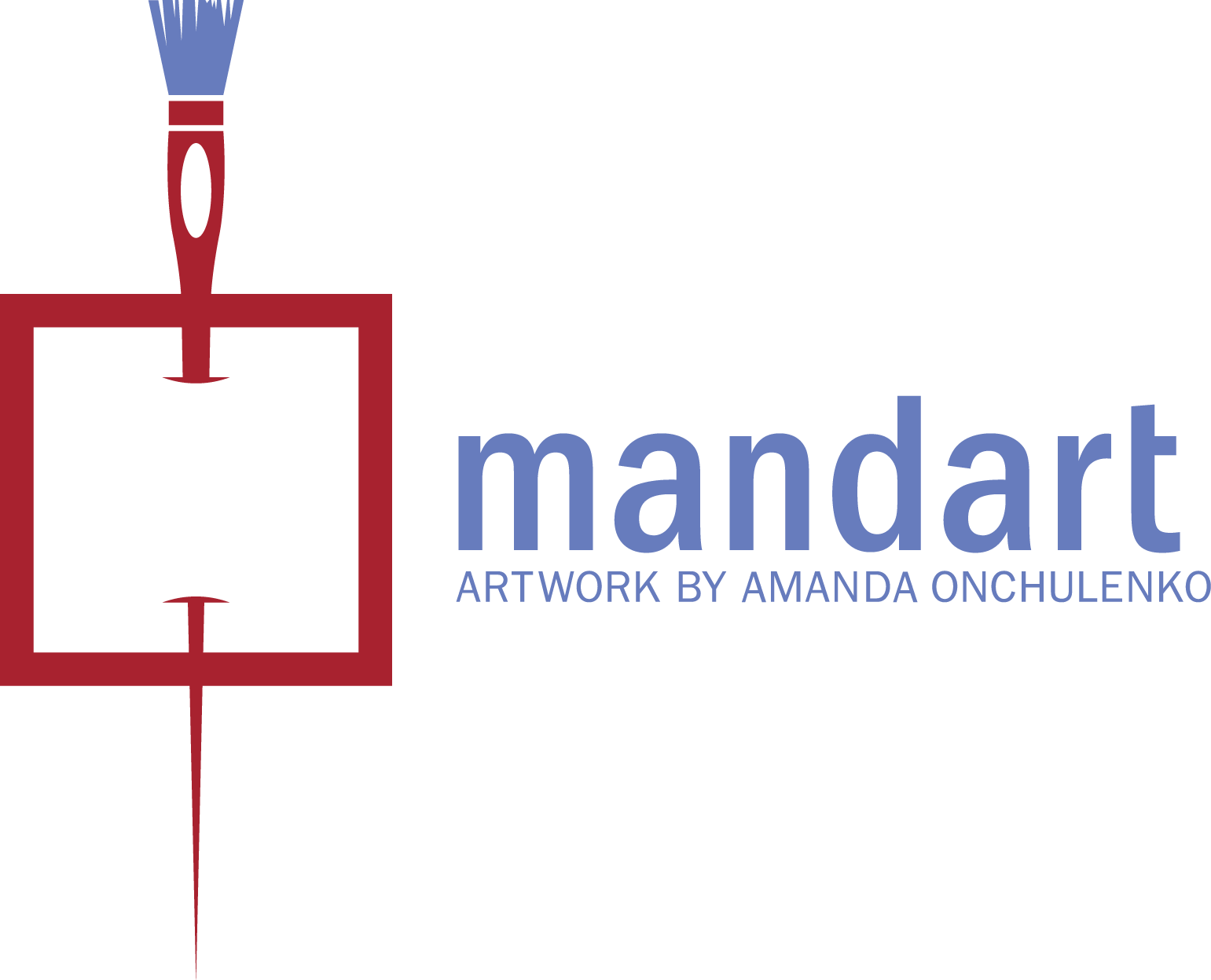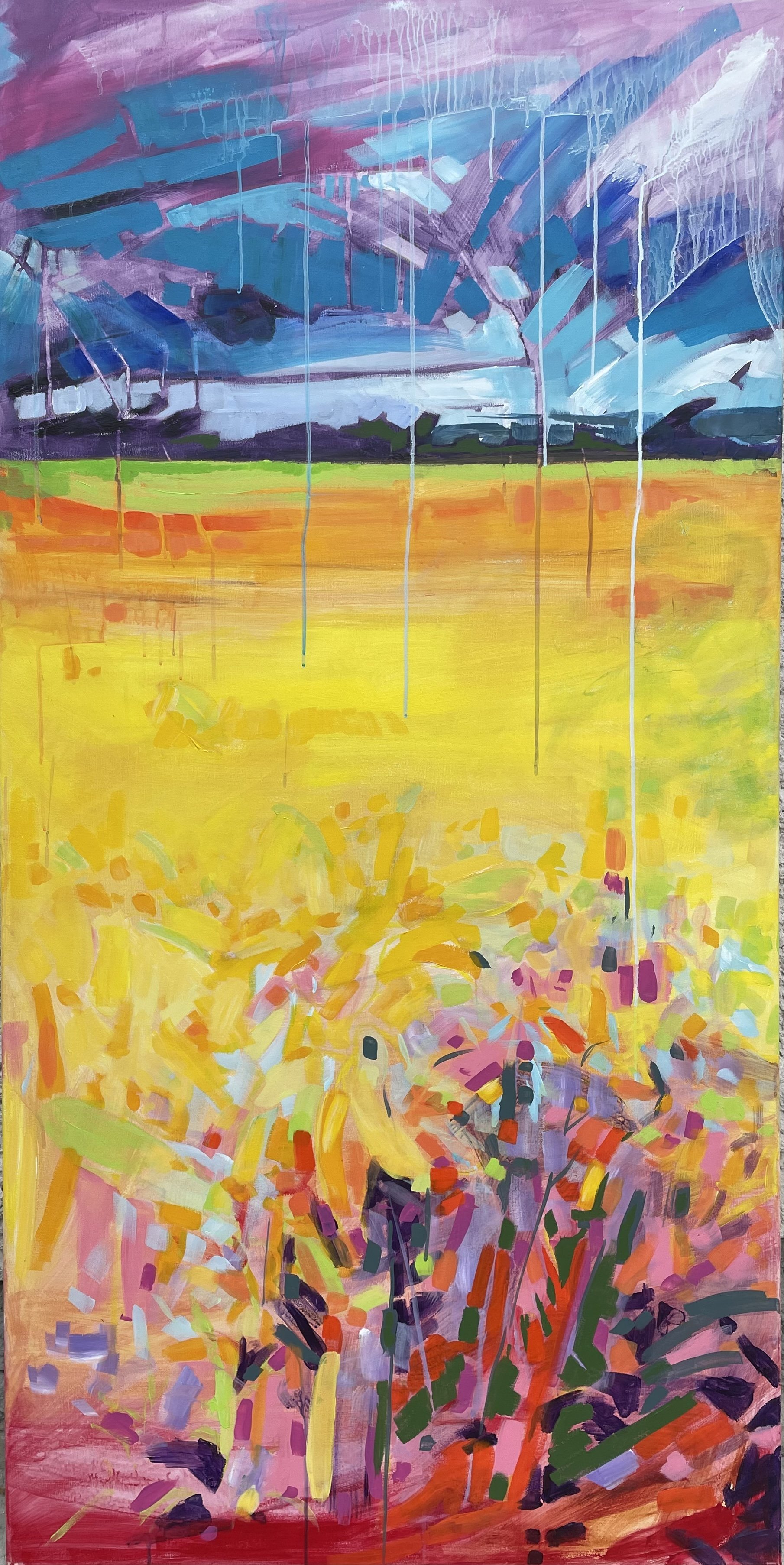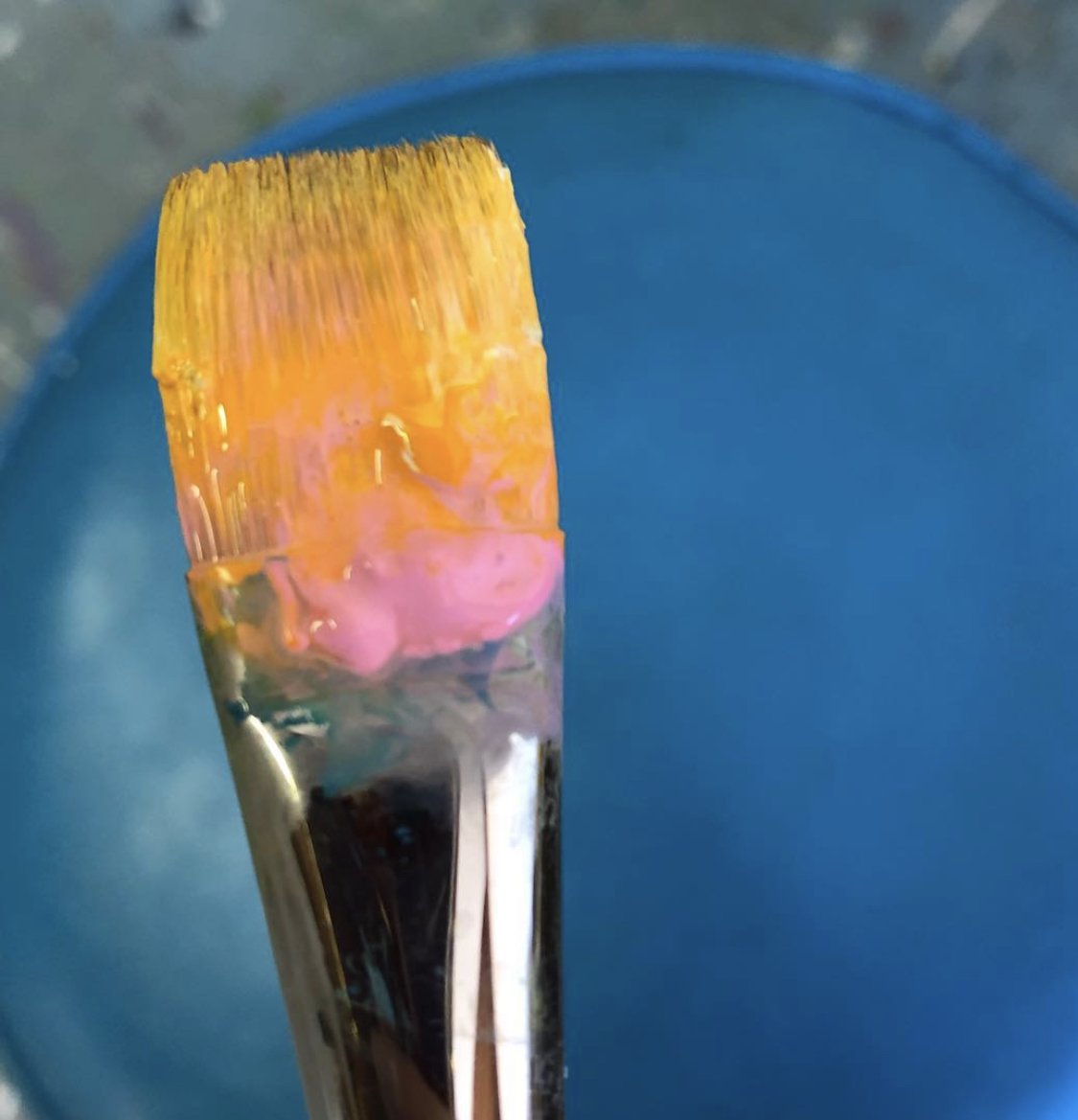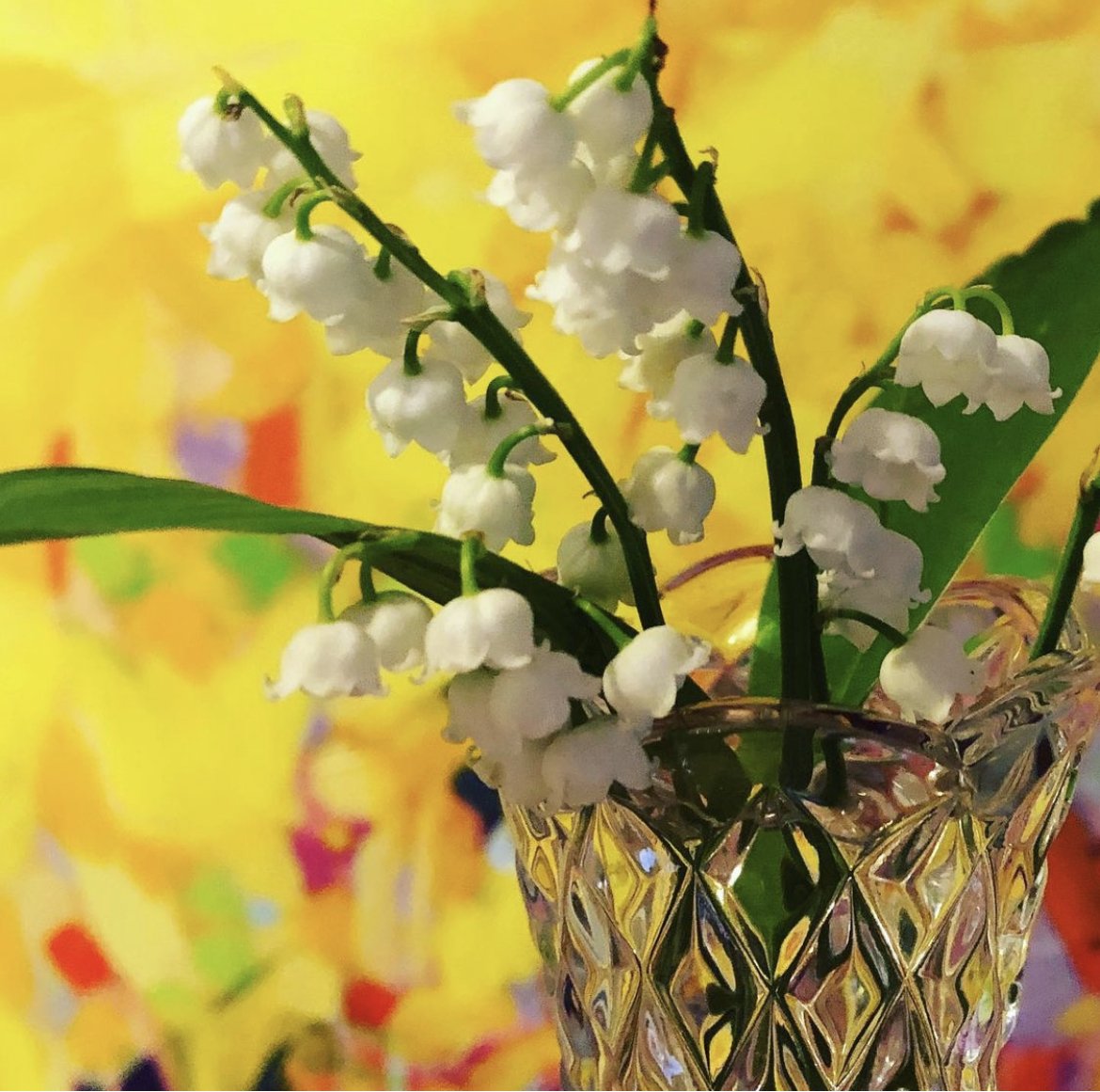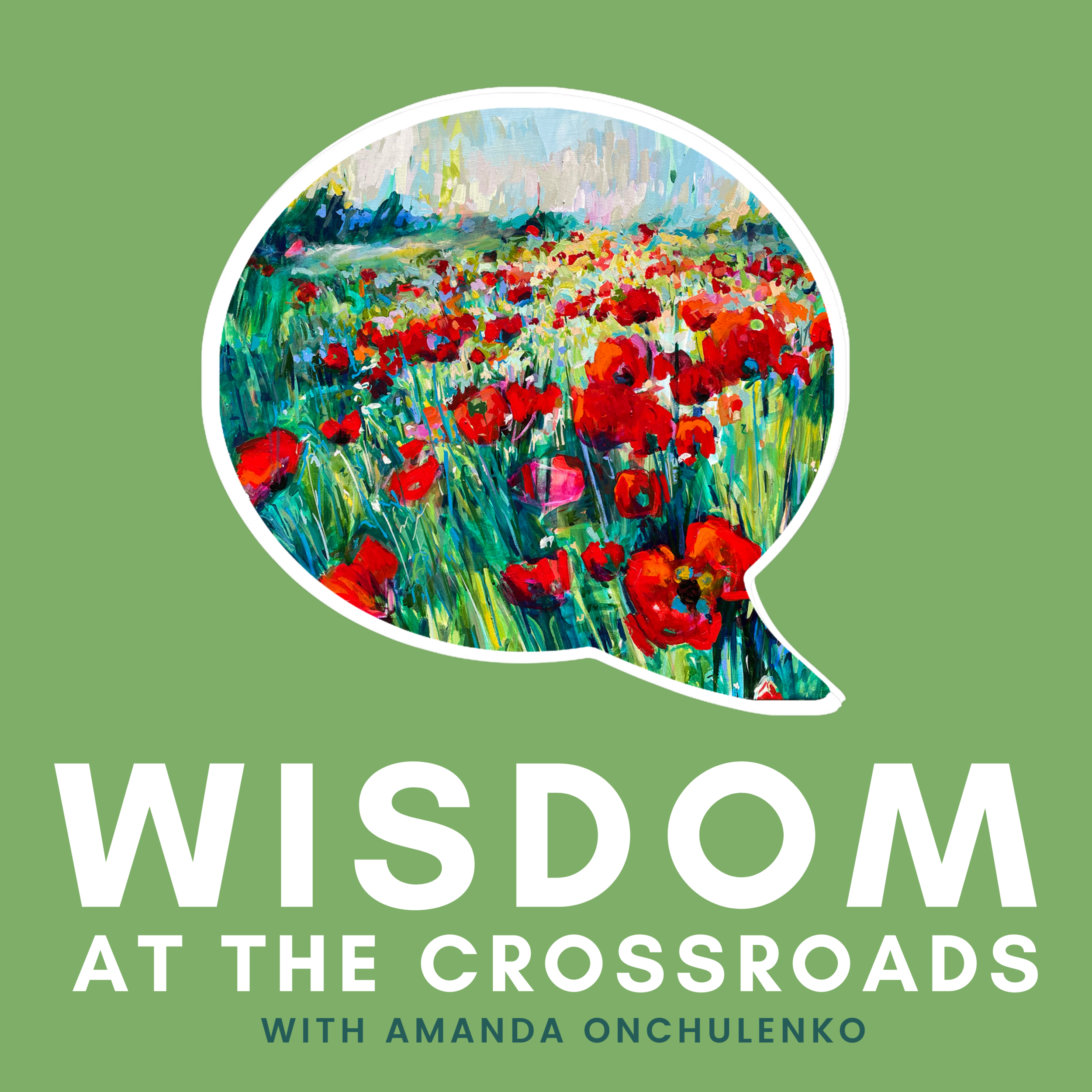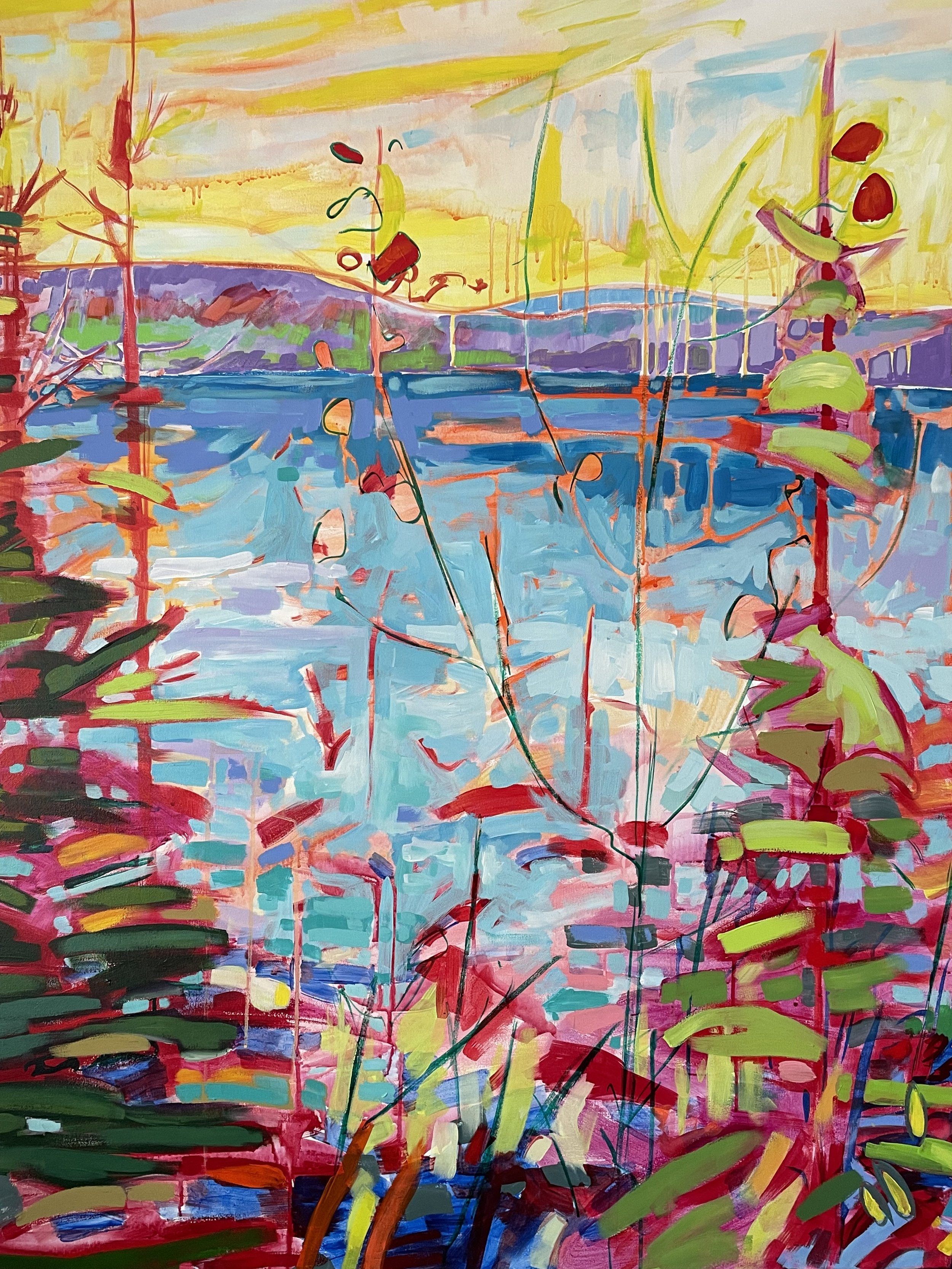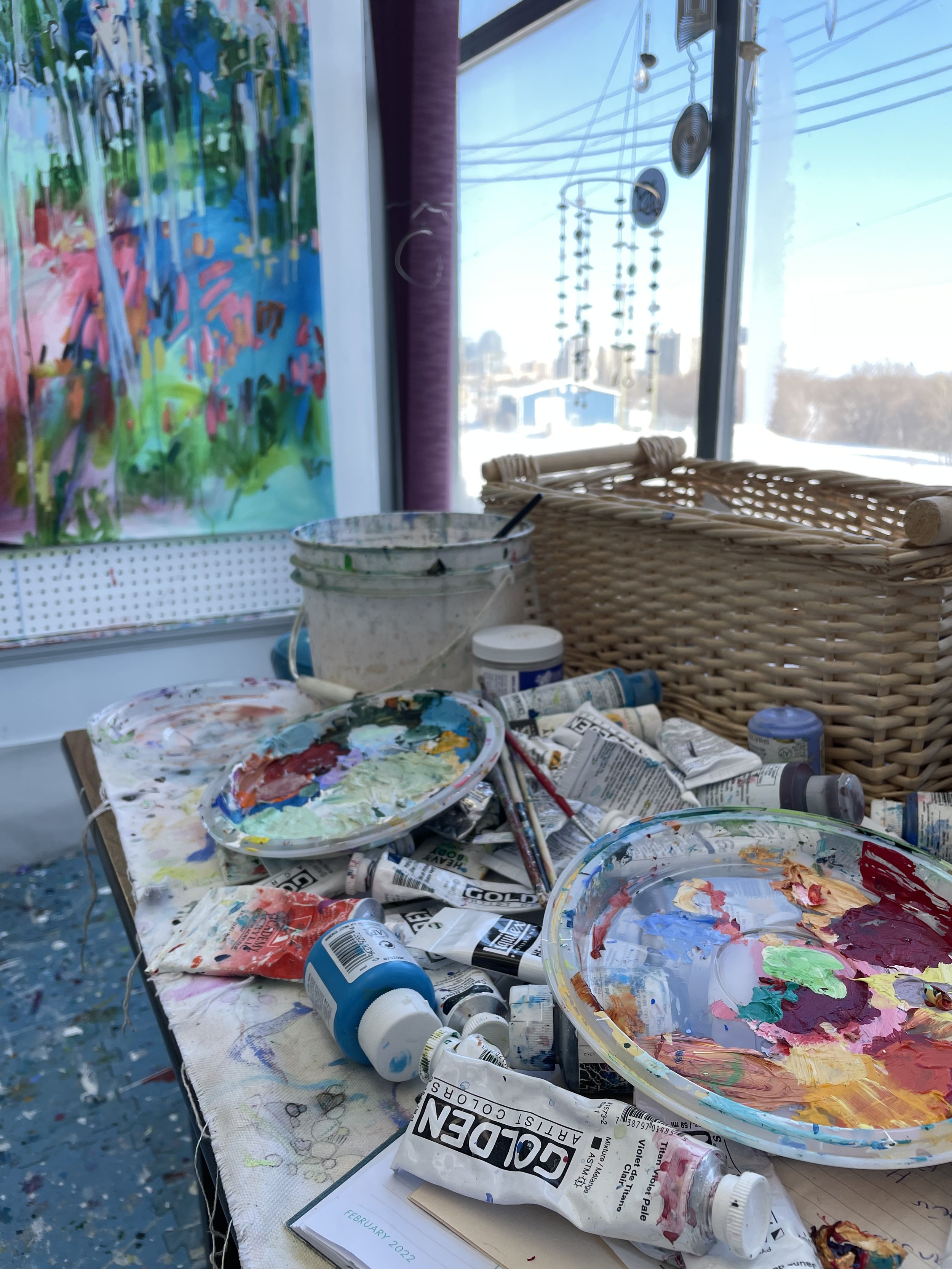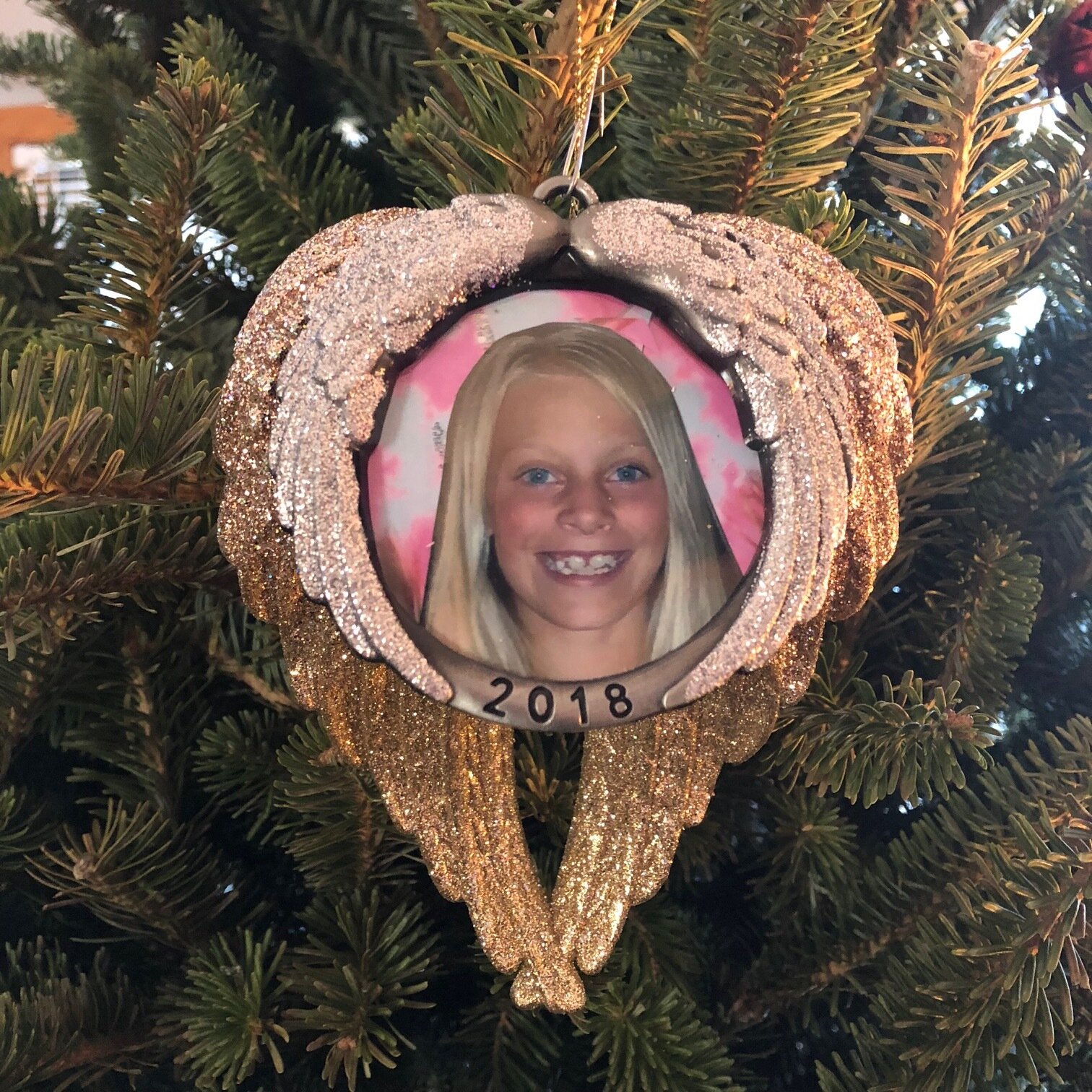Wisdom at the Crossroads, The Podcast.
This week on the podcast we are “Singing the Blues” with a little painting from “The Trespassing Series” that definitely brings back simplicity. It is a reminder that in life and in art, our work is a record of a moment in time. This little painting reminds me to give myself permission to play.
We chat a bit about critique versus criticism and i am reminded when I am true to my creative instincts the outcomes are always more successful. When we trust we Flow. Life is seriously too short to take ourselves seriously.
The meditation that begins at 13.30 in this episode’s recording will help us to Flow in the present moment..
“Singing the Blues”, acrylic on panel, 13” x 14”, 2006
Welcome back to the podcast. I want to thank you for sharing your valuable time and joining me for Episode 10. I wanted to begin todays chat at the studio with a conversation that evolved with an actual visitor, my friend and painting colleague Fia. We were just returned to our studios after absences chatting about taking breaks from our work and how it feels to come back to where we left off. Regardless of the difference and duration of our trips we both basically agreed that while sometimes fresh eyes are helpful at other times a critical eye returns and with it come insecurities and questions.
Like…what am I doing? Why am I even doing it? I think any creative can relate.
In my studio practice I usually try to finish a project before a deadline or break from painting but because our families break was a spontaneous play, of the get out of dodge now card, I came back to a commission piece I had left mid-sentence. I realise there are areas of it that I just love but while they provide interest in the colour story they confuse the composition spatially. I am not striving for realism but fundamental landscape cues do need to make the grade in this painting. I felt like I had lost my groove.
A commission can be an important part of the business equation but it often means I end up second guessing myself and stifling my painterly instincts. Choices made on behalf of someone else I guess if I am really honest aren’t always the right choices. I can be guilty of allowing my head to get in the way of my heart.
Then I need to remind myself of the many clients who were beyond happy with the piece or pieces they have commissioned. Every artist handles the commission process differently. I like to establish a size and discuss the client’s wishes to determine a theme. I then prep to create 2 pieces. The first being what I think they are telling me they want.
The second piece is what I want to paint within even broader parameters I set without any input. Usually the client will end up adopting one of the two pieces I paint but I insist there is never any obligation. While I don’t ever want anyone to invest in something they don’t love, there are limits to how much time I am willing to invest in someone elses project. Generally I find when we are true to ourselves the outcome is always more successful. Which painting do you think is most often adopted?
Some clients have even been known to adopt both fraternal twins.
“Singing the Blues” used a very limited colour palette. It was painted on panel and the colour was built up in layers to shows the action of the brushstrokes on a resistant surface
Coming back to a project mid stride this week was just not in my cards so instead I unwrapped a new 3’ x 4’ canvas. I wanted to feel the creative action of painting, to duel with the resistance and acceptance the tension of the stretched canvas offered my loaded brush. Art making grounds me in presence. And I felt I needed to dive into the process without any attachment to an outcome. Really, I just needed to play.
A blank canvas is like chocolate to a painter. You know it’s going to be delicious but like Forest Gump you just don’t know what you are going to get. I like to get back into my rhythm by preparing a canvas with gesso. Gesso is a primer that conditions the raw canvas, gives the paint something to bite into and prevents the subsequent layers of paint from spreading softly into the porous base of raw untreated canvas.
The action of doing it gets my thoughts and muscle memory flowing and helps me to get into the process. I was disappointed to realise my gesso bucket barely had a sniff remaining but with the final dregs I managed to inscribe a word into the surface. This setting of an intention is a casual addition to my process. Words are powerful and I like to paint a word into the protective base layer. It is whatever comes to mind without too much conscious thought. In this way, I feel I am setting the tone of the project and that broad intention might also provide another opportunity for a future viewer to make a connection to.
The word CHI came to mind on this morning and I had just enough opaque gesso to complete the job. CHI is the life force within us, universal energy. I guess I needed to tap into my own energy to feel my own presence in the process, to ground myself in my studio practice with the act of beginning. The making of initial marks and the covering of the surface in a foundation of gestural colour was my goal. While these marks may or may not come to the surface in the finished version of this painting, the energy or Chi will remain within it in the remnant marks that describe the action of my brush on the canvas. The process is active and meditative, my only concern to address the physical need to feel the action of the brush against a surface.
Once I ran out of opaque gesso I used clear gesso and a limited palate that included a new Golden green gold and … wait for it….benzimidazolene yellow medium, in liquid acrylic. I really have to ask, who makes up these names? How do we even pronounce that… and with an accent no less?
This liquid pair was joined by a regular favourite of mine, quinacridone red light, again, those names? I had made sure to move the in progress works off the painting wall so I would , A) not drip on them and B) to avoid any comments from the gallery as they try to speak up with requests for a bit of this or a bit of that as they can distract me by catching the attention of my peripheral vision.
My colleague and I reminded each other that a painting is not a jurist: there is no need for judgement. Sometimes we can gain real value allowing ourselves to engage in the painting process for the sake of the process itself.
Life is always lived in the details. This one shows what was intended as underpainting but turned into the main event.
I don’t know where this piece will end up. I don’t have a plan for it beyond the vehicle it provided today as a starting point and my personal journey to connect to a part my creative self.
So far it is a document of a moment in time, no more and no less. As each painting episode on this surface evolves the canvas becomes a cumulative tally of all those moments, documented in layers and recorded in colour.
Before we finished our visit, Fia and I talked about paintings at the studio that we consider to be finished but later we think oh yeah I could add this or change that. The conversation reminded me of a book launch I had attended years ago. The book celebrated a chapter in the career of well known Manitoba painter Ivan Eyre. There he was discussing his work and I put up my hand to ask a question I am often asked, “When do you know your work is finished?”
He paused before he responded, then noted the fact that historians get frustrated with him because years after the fact and even after a painting has been published in a catalogue or book, he has been known to redress a painting from his new perspective with the intention to somehow improve it. Those efforts to polish or clean things up in a composition can be the detriment of us all. I was glad to learn I was not alone in my backward glances toward earlier works. Every piece we create is a record of where we are at a particular point in time. The difference between old and new work is growth. I try to accept the lessons I have learnt along the way as a document of an age or a stage that will become part of the equation that illustrates the story of one painter’s work in art.
Photographing the Neighbours Poppies to use as future inspiration
“Singing the blues” inspired a new body of work in textiles in 2021. This is a detail of one of the panels.
“Composition” exhibited at La Maison Des artistes in Winnipeg in 2021. Singing the Blues provided inspiration for 2 of the 16 , 20” square panels in textiles.
In this episode I want to introduce you to a small painting I kept because I loved its simplicity. It taught me to leave well enough alone, to walk away from a painting before I addressed the urge to clean it up and tamper with the initial marks I had made. It hails from 2006 and was part of what I then called the “TRESSPASSING SERIES”. I may have had an issue with boundaries at the time but I won’t judge my younger, frazzled young mother, self, for finding inspiration in the front yards of friends I had yet to meet.
2006 was early in the digital age. Then I was usually armed with my elf camera and developed film in duplicate batches. It was cheaper and it gave me the opportunity to write a note to the homeowners and share a lovely image of their fleeting perennial garden with thanks. This little painting is called “Singing the Blues”. It is 13” x 14’ and painted on a plywood panel. The unusual proportion is the result of my adventures in the hardware store where I divided a 4’ x 8’ sheet into a a group of proportionate pieces so I could play in series without feeling I was splurging on materials. My current advice to my younger self… Just buy the darn materials, its worth it and so are you!!!
Anyhow, I prepared the surface with gesso in multiples, a few at a time and taped some inspiration photos above them on my paint wall. The photographs provided a starting point. They reminded me of something that had piqued my interest and inspired me to take the picture in the first place. I never had time to act on my creative urges instantly so this was my way of collecting visual information for later use. I was the mother of young kids. In fact I used to joke I was the stay at home mum who just wasn’t home. .. And was only half joking.
The snapshots acted like flint, igniting the creative process with a foundation in landscape in general but with no intention to replicate the details of a particular place or space.
The poppy motif inspired this pair of Mandart pillows in 2021. “Solitaire” shown here.
“Villagers” will be part of a pillow pop up in 2022. Drop me a line if you would like to be notified when the pop up pops up.
In “Singing the Blues”, just like in the understructure of the piece I was painting the other day i was using colours opposite on the colour wheel to create a foundation or compositional structure,For example this little guy hs a pale yellow sky. This image was going to feature a cluster of fiery red poppies from a local lawn which I naturally underpinned in Liquitex’s brilliant blue liquid acrylic. It is a favourite colour of mine that i have had some difficulty finding lately.
Sometimes in painting I put pressure on myself to produce some predetermined outcome but with my freshly cut hardware store boards I gave myself permission to just play and see what unfolded. By starting without a destination the little composition is fresh and clear and ultimately, to my mind, more successful.
Luckily I had more boards to play with so I left this piece to cure as I went onto something else. The pause also cured my desire to clean it up or overpaint in a more naturalistic or expected scheme. My use of contrasting colour foundations can sometimes flatten my paintings spatially as tend to defy the natural order where blues recede into the background and warm reds, oranges and yellows step forward. I find the value of the colour used can help that effect from being disruptive but really does it even matter? What is important to me is the developing relationship between elements within the composition’s surface.
Thank goodness for the garden, in real time and in art. Organization may not be my best feature but I am resourceful and don’t shy away from emergency photography in poor light. A resilient icy snowbank works in a pinch. and yes i am gripping my toes trying not to slip and fall on a rink like back doorstep. Colour vs Winter is real here.
When I began my art school journey it was at the tail end of the photorealism era, I am not Chuck Close and I am in no way attempting to replicate the real world or any existing place, space or event. I am simply creating my own response to landscape where subject is secondary and the final product may or may not bare any resemblance to the inspiration that ignited the journey through process in the first place.
For those interested in my photorealist beginnings stay tuned for episode 13 at the end of Season 1.
There we will learn a little about where my art journey began and how the support of a mentor who saw the painter within me, possibly before I even knew she was there myself, is so important.
But for now we can take away a couple of lessons from “Singing the Blues”: like, let’s just play kids.
Life is seriously too short to take ourselves too seriously. Life and work should be fun.
Let’s remove our attachment to outcome, even temporarily. I find when I allow myself to fully feel the creative actions I am engaged in I am also allowing myself to be fully immersed in a process. In the creative process I can find myself in a place where the world quietens around me, and I am fully present. I guess really, I am at the intersection, where action and presence meet.
Don’t get me wrong, studio practice is not all fun and games. It requires discipline and practice too. One last lesson “Singing the Blues” taught me was that while the hardware store can be a perfectly good resource for a painting support, if I add in the cost of my time, energy and resources, there was no economic advantage whatsoever to my resourceful little scheme.
Let’s be sure to remember we and the work we create are worth the investment in materials, always.
Thank you for tuning in to this episode. I hope the images are helpful and that you are finding something of your story within mine by listening in to the podcast, or catching up through this blog.
It’s all FREE content that I very happy to share with you. If my work or words inspire you please consider sharing the podcast with a friend or writing a review. You can listen to the full episode anywhere you get your podcasts.
This week’s meditation begins at 13:30 in the recording.
Feel free to leave your questions or comments on the website or find me on instagram @mandartcanada. I would love to hear from you
Until next time, stay well,
all best
Amanda
